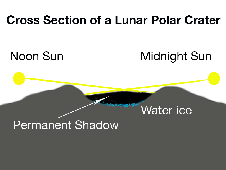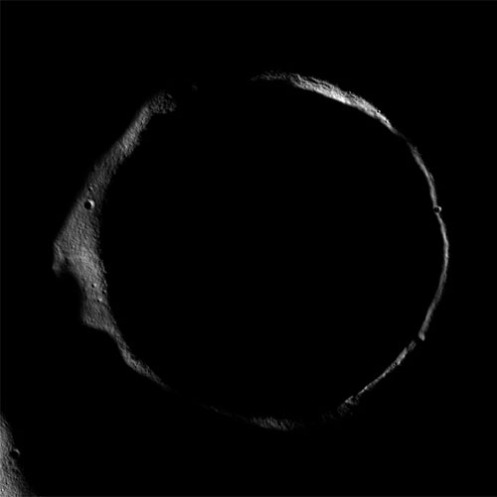External Darkness – Erlanger Crater
What on Earth is this? (sorry, it’s not on Earth)
This beautiful image is a lunar crater called Erlanger. The “bright ring” is the rim of the crater poking into the sunlight. Erlanger is located at latitude of 87 degree north, which means it is very near to the lunar north pole, and this making the crater interesting…
We always heard about looking for water on the Moon, why is it important? Because water can be a useful resource for future lunar inhabitants and we need to determine where are the best places to send our lunar explorers.
But then, can water exist on the Moon? The Moon practically has no atmosphere, thus its surface is exposed to the vacuum of space. Furthermore, the surfaces that are bathed in sunlight can reached a temperature up to 120 deg C. Over the course of a lunar day, its entire surface will see sunlight and thus any ice exposed will be turned into water vapour and lost in space.
The catch here is, if the ice sees the Sun then it will be evaporated. If it never sees the Sun, then it may continue to be ice. So, where on the Moon can this be?
 The answer is the poles. The Moon’s rotational axis is only tilted 1.5 degrees with respect to the ecliptic. This means that the Sun will always be low at the horizon at the poles. The low Sun will therefore have no chance to illuminate the polar craters’ floor and these craters can have permanently shadowed floors where water ice can exist. The temperatures within the craters do not go above -170 deg C, so the ices do not have enough energy to evaporate.
The answer is the poles. The Moon’s rotational axis is only tilted 1.5 degrees with respect to the ecliptic. This means that the Sun will always be low at the horizon at the poles. The low Sun will therefore have no chance to illuminate the polar craters’ floor and these craters can have permanently shadowed floors where water ice can exist. The temperatures within the craters do not go above -170 deg C, so the ices do not have enough energy to evaporate.
And Erlanger is one of these craters. The bottom of the crater is in eternal darkness, but its rim is just high enough to get some sunlight, as seen in the image above that was beautifully captured by the Lunar Reconnaissance Orbiter (LRO).
LRO had team-up with Chandrayaan-1 to take a look at Erlanger last week, hoping to find evidence of water there. So far, we only hypothesise that water ice may be there, which may be the leftovers from comet impacts long long time ago, but still lack of strong evidence.
LCROSS, another probe which is launched together and then later separated with LRO, is also another mission to search for water on the Moon, but in a different way. Instead of collecting data using radio pulses, LCROSS will impact the lunar pole hoping that this will kick up some evidence of water in the debris plume.
Will they find water? Maybe yes, maybe no… I think we just have to wait…
In the meantime, let’s enjoy the picture.




[…] the world – Malaysian astronomer Teoh Hui Chieh swoons – as I and many others did – over an image of Erlanger Crater returned by LRO. The image is just breathtaking, a ring of light against a black velvet darkness, but it’s not […]
Welcome to The 118th Carnival of Space! « Cumbrian Sky said this on August 31, 2009 at 4:27 pm |
[…] 2 days after I wrote about how Chandrayaan-1 teamed up with LRO to take a look at Erlanger Crater, I got the news that we lost radio contact with it. I didn’t write about it that time because I […]
Goodbye Chandrayaan-1 « My Dark Sky said this on September 6, 2009 at 3:26 pm |
[…] Set for LCROSS Although the bi-static radar experiment to look for water ice in the polar crater on the Moon failed due to the dying Chandrayaan-1 probe, we still have not yet used up all our […]
Target Set for LCROSS « My Dark Sky said this on September 15, 2009 at 6:08 pm |